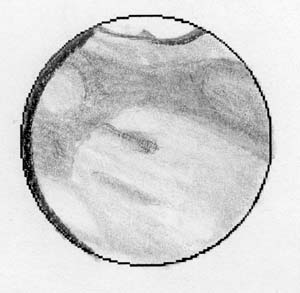
Sketched July 22, 2003 from my back deck 4:00 a.m. pacific DST (daylight savings time) or 11:00 UT. Good observing night, but morning fog was visible on the horizon and rose as I was observing. I never had any moisture on the telescope or sketching materials, however. At 4:19 a.m. the ISS made a spectacular pass from WNW to SE. Mars was flanked by setting Capricornus on the west, and a bright streak of ISS-light on the east.
| Date: 07/22/03 Lat 37.6N, Long 122W, elev. 200 feet | Sketch Time (UT): 11:00, (local time): 4:00 a.m. DST |
| Central Meridian: 102° | Filters: #80A light blue, #25 red, #21 orange, #11 yellow-green |
| Instrument: 4-inch (105mm) f/6 Astro-Physics Traveler Apo refractor. | Distance from earth 0.46 AU, 69m km, 43m miles |
| Magnification: (4mm) 376x Zeiss Abbe Ortho combined with a 2.4x AP Barcon Barlow | Transp. 3/6, Seeing 6/10, Antoniadi (I-V): II |
| Apparent Size: 20.6" | Magnitude: -2.1 |
I tried a couple different things for this sketch. I used 4 different filters. #80A (light blue) seemed to bring out clouds and I suspected the north polar hood (not the north pole, but a haze hovering over the area). Red #25 brought out the two albedo features on the central meridian - Solis Lacus is the "bulb-shaped feature, known as "the eye of Mars" and below it (north) is Tithonius Lacus, a cigar-shaped feature, which was not visible without the red filter. This is approximately the location of the great Vallis Marineris, the "Grand Canyon" on Mars. It is a chasm the length of the United States. We can't actually see the surface features, just light and dark markings. Orange #21 was also useful in bringing out albedo (dark) features. And Yellow-Green #11 makes the planet look weird but also helps show some features. Olympus Mons, the great volcano (or at least the clouds above it) were visible further to the north when I had the 80A light blue filter in the eyepiece. And near the terminator Chryse was visible.
Mars, in this sketch is reversed N/S. South is shown at the top of the image. The south polar cap is the prominent feature, and shows a notch that was quite distinct to me. Terminator is where daylight ends and evening begins. The terminator is on the left and the planet is rotating left to right. In my sketches the planet rotates martian east (left) to west (right) to match most other images and sketches. Look for features rotating from left to right in the drawings from night to night.
Details about Mars: Diameter 20.6 arc seconds (Jupiter is about 30 -50 arc seconds in diameter depending on its distance from earth). Central Meridian 102 - the imaginary line passing through the planetary poles of rotation and bisecting the planetary disk, and is used to determine the longitude during an observing session. The martian disk is now larger than last opposition in 2001, and we still have a month until opposition!

White Oaks Home | Sketches Index | Mars 2003 Index | Back | Next